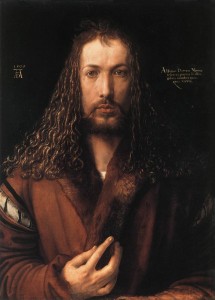Welcome to fancy Friday! Forget casual Fridays—fancy Fridays are where it’s at. Fridays are for celebrating. So why not look your best for the weekend? Here at ADP we believe the same thing. And in honor of fancy Fridays, we’re bringing you some of the best work from the artists who really understood the concept of living the fancy Friday life every single day. So welcome to our first installment of #fancy, a look at portraiture throughout the Western tradition.

First up—Albrecht Dürer!
Albrecht Dürer was one of the foremost artists in northern Europe around 1500. He gained popularity for his incredibly detailed prints, Four Horsemen of the Apocalypse and Adam and Eve being his most famous. Dürer was also an incredibly gifted painter and had a wide range of interests outside of art as well. Much like Leonardo da Vinci, he loved to study plants and the human body.
Dürer traveled from his native Nuremburg to Italy in the 1490s, where he gained a new sense of what being an artist meant to the Italians. In Nuremburg, artists were seen as more of craftsmen. In Italy, painters had the status of intellectuals and sometimes even nobles. Upon his return to Nuremburg, Dürer had the idea that maybe Nuremburg should start treating him more like the Italians would treat their artists.
And in this context we get Dürer’s famous self-portrait at 28. He’s clearly been influenced by the balanced compositions of the Italian high Renaissance, but executes his self-portrait in a truly northern European manner. The attention to detail is astounding—there have been graduate papers done on what can be seen reflected in Dürer’s eyes when the painting is blown up to a gigantic size.
Dürer doesn’t hold back anything for his self-portrait—he wants to show that artists are skilled workers who deserve a higher place in society. He paints himself in his best clothes—look at that fur coat! Such a deep red. And his hair is excellent—he clearly made sure that every strand looked absolutely flawless. His expression is serious yet amazingly self-confident—I’m definitely getting some Zoolander-esque Blue Steel vibes.
However, you may not have been thinking Blue Steel at all. You may have had the following question floating around in the back of your head (I know I did): Why does Albrecht Dürer look like Jesus?
This painting follows traditional patterns for depicting Jesus. Dürer faces our gaze with his hand up—though not in blessing, this gesture coupled with his physical appearance and format of the picture automatically bring to mind paintings of Jesus. Would this painting have been considered blasphemous? Or more of a Kanye-level inflation of ego?
Dürer could have been treating the “humans are created in God’s image” statement extremely literally by painting himself in traditional Jesus style. Or, most likely, he could have been highlighting the fact that artists, unlike the common laborer, are endowed such knowledge and skill by God. He then proceeds to demonstrate this by painting himself in a way that shows how important he is to society—he paints altarpieces and makes woodcuts that further the word of God. Thus, he is indispensable and deserves to be treated as such.
Rather than inflate his ego, Dürer wanted everyone in Nuremburg to understand how important art is to their society, and by extension how important artists are. His position was key to a good and peaceful society and he wanted everyone to know it. Basically, Dürer gets the honor of the first #fancy post because of his daring to speak out about the importance of art while remaining completely flawless.







